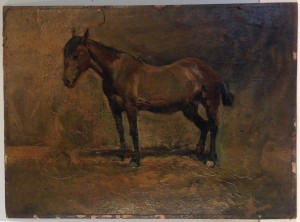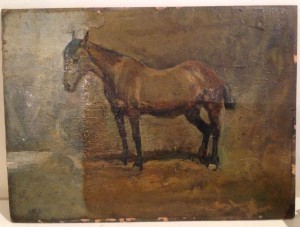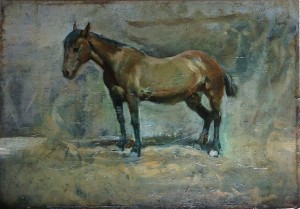It seems the older we get, the busier we get. I for one will readily admit that often when I say I am busy, I am just taking time out for me, or working quietly on something in the background.
Well it’s been 6 months since my last post, but I have definitely been working on many things in the background, including moving to Victoria’s beautiful Mornington Peninsular to set up Cash Brown & Co., a small business dedicated to the preservation of fine art. In between restoring artworks and the long process of setting up a conservation atelier from scratch, I am still making art, albeit very slowly.
Conservation work is painstaking, but it it really rewarding to see works restored to their former glory, like this little oil sketch on cardboard by British artist Sir Alfred Munnings.

Sir Alfred Munnings_The Postman’s Pony, Dedham, Suffolk_circa 1910_oil on cardboard_225 x 300 mm. Before treatment.

Sir Alfred Munnings_The Postman’s Pony, Dedham, Suffolk_circa 1910_oil on cardboard_225 x 300 mm. During treatment.

Sir Alfred Munnings_The Postman’s Pony, Dedham, Suffolk_circa 1910_oil on cardboard_225 x 300 mm. After treatment.
As a conservator, the main aim in caring for artworks is to maintain or revive the artist’s intention. As you can see above, the varnish is old and yellowed and there are losses of paint. The board was also really buckled and the paint was cracked and lifting. None of these things are likely to have been how the artist intended the work to look. The varnish did however protect the painting over the years, and artists knew they would yellow and require replacing at regular (say every 50 – 70 years depending on conditions).
Once flattened, cleaned, filled, in-painted and re-varnished, the lively little work has the freshness and vitality restored. Furthermore, the varnish selected will not yellow for hundreds of years, and will protect the paint pigments from UV degradation.
All materials used in conservation of paintings have to be detectable, reversible and not cause any damage or loss to original materials. This is where applied science comes into the process and it can me a complicated and time consuming process at that! As a painter, and conservator of paintings, I find that process very challenging, but equally rewarding as problem solving for a living is a wonderful way to life a life.
For more information about conservators, what we do and why, please see AICCM – the peak professional bdy for conservators in Australia.
Leave a comment